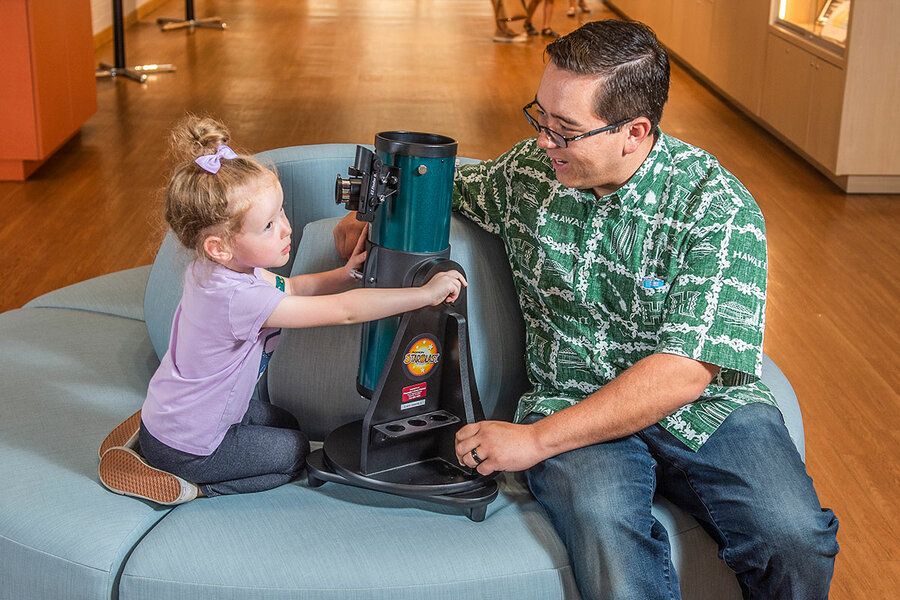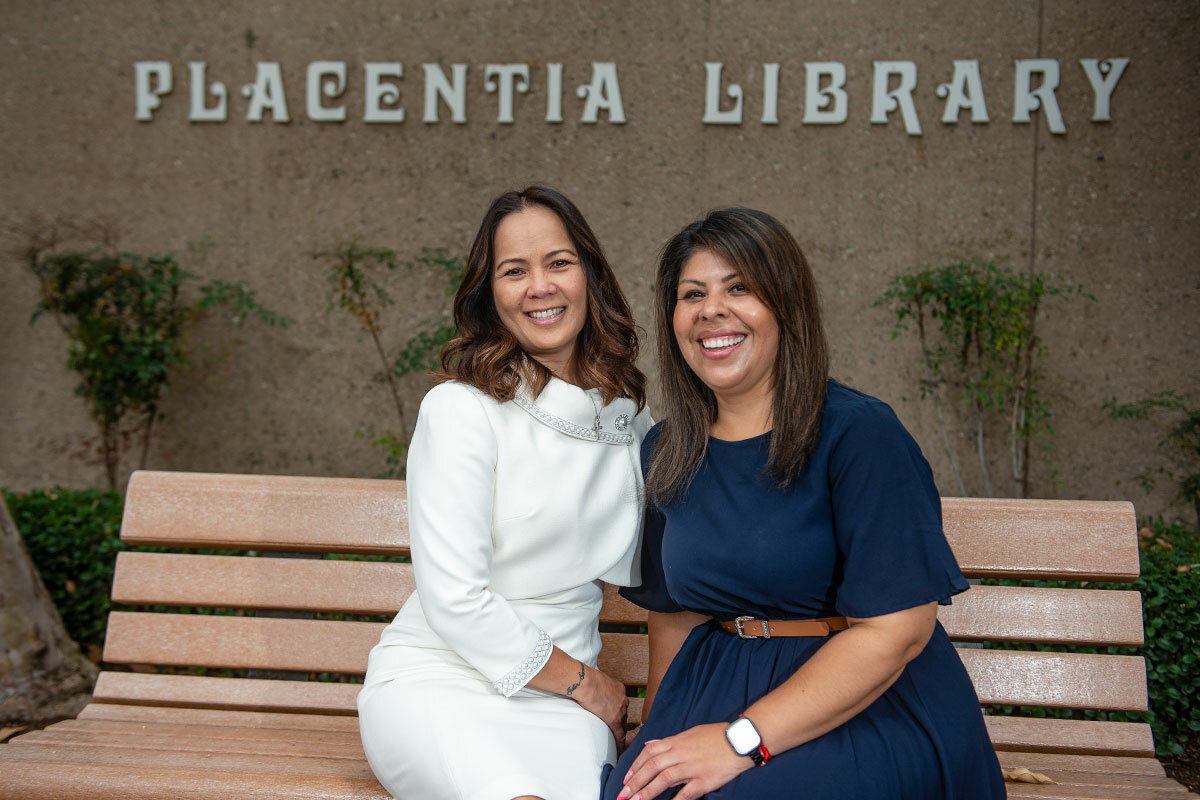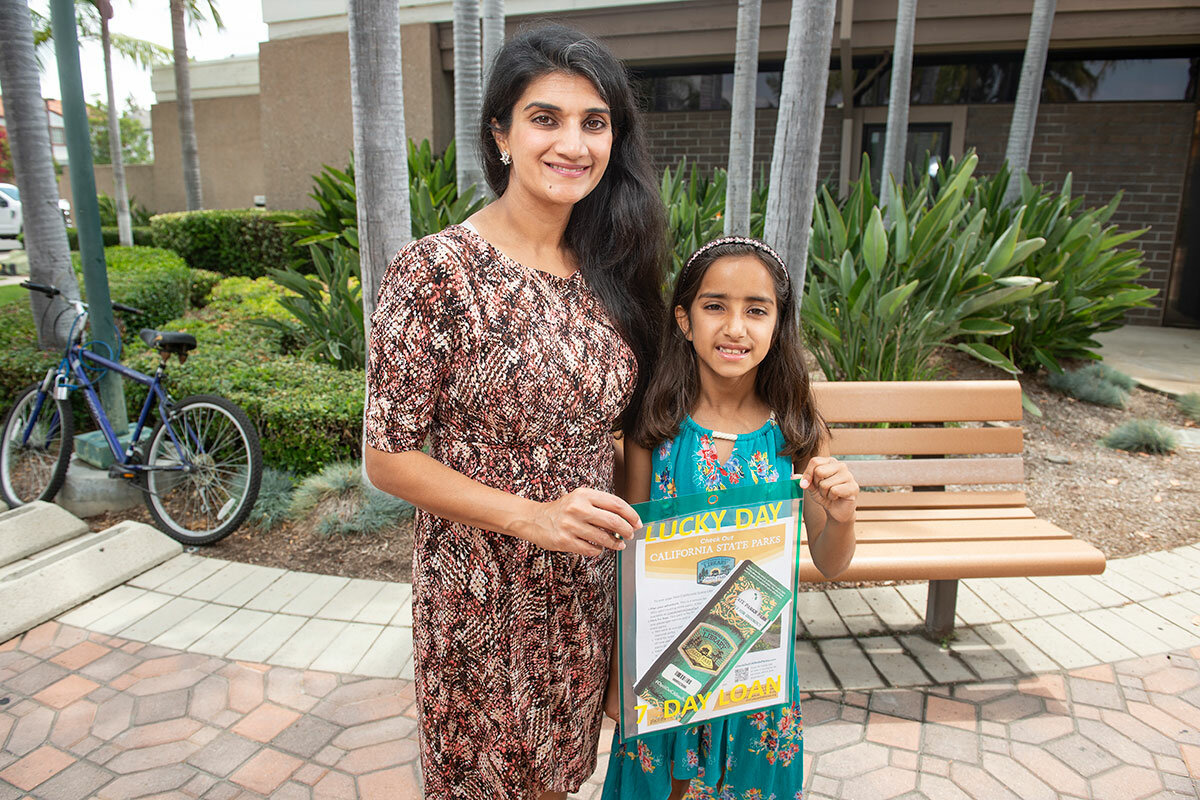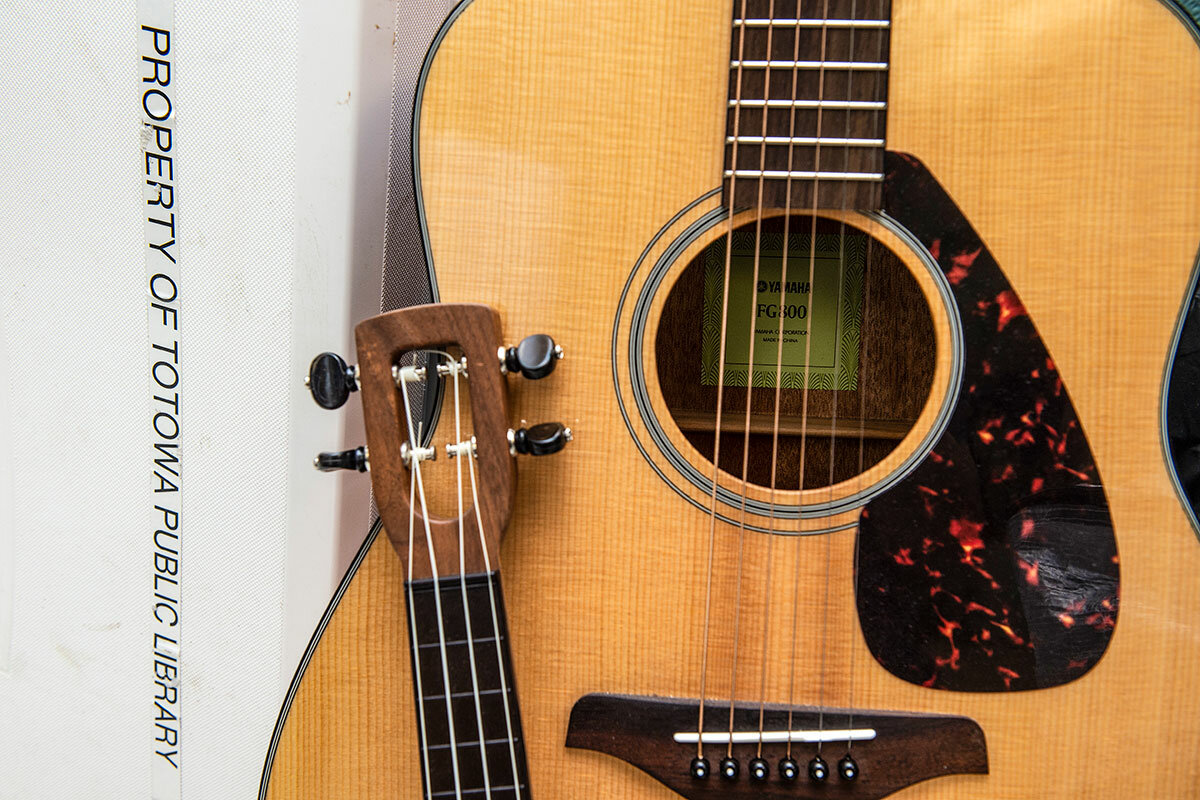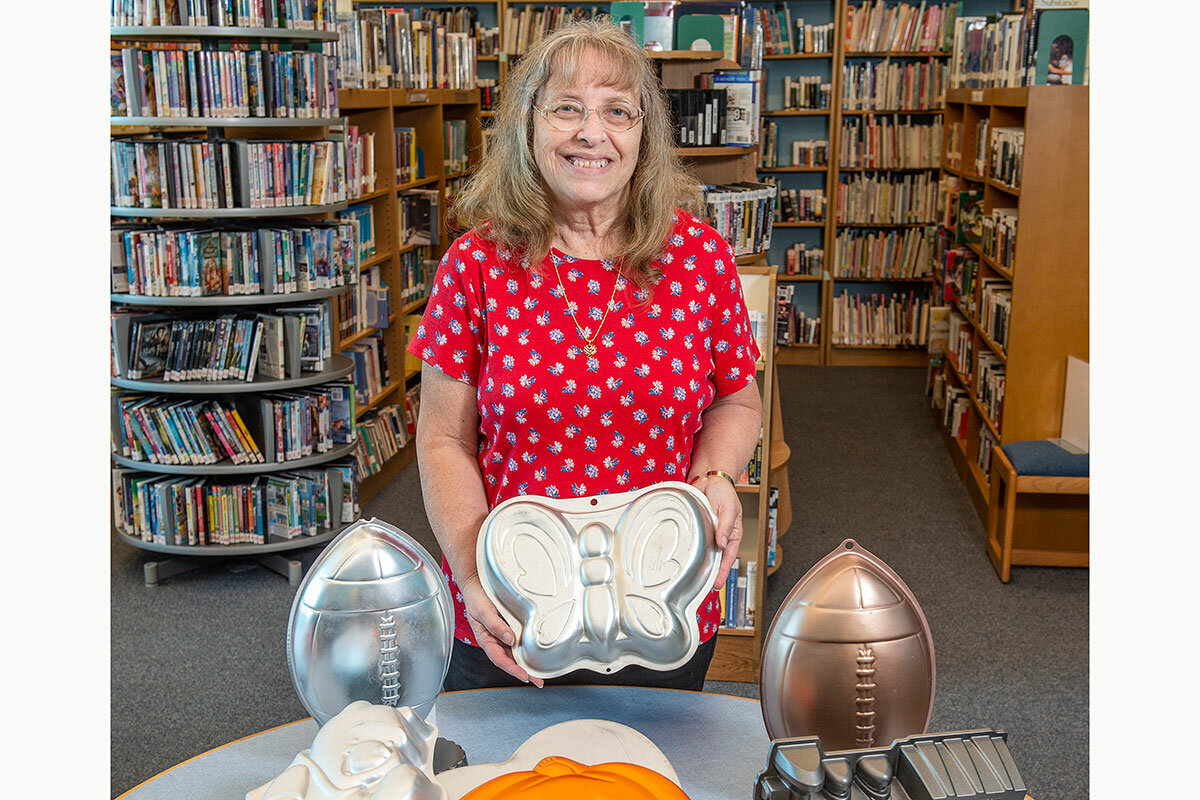What can a library card get you? Try a popcorn maker or ukulele.
Loading...
| Placentia, Calif.; and Totowa, N.J.
The first clue to this library’s offbeat lending habits sits inside a tall glass display case near the entrance. Sprinkled amid storybooks, atlases, and a globe are a remote-controlled drone, an electric balloon pump, a DJ mixing board, and a Nintendo game console.
And those aren’t the strangest items available to borrow. A few steps away – past a Lego dinosaur and a pair of hulking automated checkout towers – an open binder lists more than 100 nonbook offerings, from bounce houses and hedge trimmers to a ukulele, a popcorn maker, and a $585 cheese warmer.
The Dewey Decimal System never saw this coming. It’s called “the library of things,” and Placentia’s collection is part of a nationwide movement that is reshaping public libraries and how they serve patrons in the digital age.
Why We Wrote This
Through ingenuity and bold ideas, libraries ensure their relevance as community hubs – now and in the future.
More than half of America’s 9,000 public library districts now lend nontraditional objects, says Maria McCauley, president of the Public Library Association. Many have also revamped their event calendars to include such programs as punk rock aerobics, speed dating, cow milking demonstrations, and indoor miniature golf.
These and other innovations reflect the ingenuity of librarians in adapting to changing community values and needs. “Libraries all over the country are doing creative things like this,” Ms. McCauley says.
The beyond-books trend began, depending on who is asked, either a decade ago in Sacramento, California, or in the 1800s, most notably in Braddock, Pennsylvania, a Pittsburgh suburb whose library featured a boxing ring, eight billiards tables, a swimming pool, a bowling alley, a game room, and a 964-seat music hall with cushioned opera chairs.
The Sacramento model has spawned a wave of copycats, including Placentia’s public library. Its 19th- and 20th-century predecessors are largely forgotten, says author Wayne Wiegand, a professor emeritus of library and information studies at Florida State University.
“History holds thousands of precedents for what’s now called a movement. The problem is librarians don’t generally know much or care about their past,” he says.
Balancing the books
“It was one of those middle-of-the-night things,” says librarian Lori Easterwood, recalling the 2013 inspiration for Sacramento’s pioneering library of things. After waking up with the idea and the name, she checked Google, saw nothing, and jotted a note. “I used to keep a pad of paper by the bed,” for overnight thoughts, she says. “Eighty percent were inexplicable the next day.”
This brainstorm wasn’t completely out of the blue. For several years, Ms. Easterwood and colleague Jessica Jupitus, a branch supervisor who moonlighted as a roller derby queen, had been experimenting with various “harebrained schemes” to attract new clientele and keep their library relevant.
They launched “zombie survival aerobics” classes, hosted “bad art” craft nights, sponsored “haunted stacks” tours in which the “ghosts” of historical figures recounted their gruesome deaths, and organized truck rallies with Brinks armored cars, drag racers, and SWAT vehicles.
For Ms. Easterwood’s library of things concept, the duo successfully applied for a $55,000 state grant. “Sometimes people don’t just need a book about sewing – they need the sewing machine too,” the application said. To decide which products to add, they set up a website for patron suggestions.
As part of the grant, library employees also received customer service training from the Ritz-Carlton luxury hotel chain. It would come in handy.
In early 2015, when Sacramento’s things collection debuted, the atmosphere was a little bit crazed. “It became very popular very quickly,” says Justin Azevedo, who managed the lone branch that offered the program. “We had huge waitlists.”
Storage was a challenge. Checking in books and DVDs is one thing; checking in guitars and lawn mowers is trickier. “We had sewing machines under people’s desks,” Mr. Azevedo recalls. But eventually, the kinks were ironed out, and staffers even mastered skills not normally taught to library science majors. “I learned how to replace a sewing machine flywheel and how to restring guitars,” Mr. Azevedo notes.
By the end of the first year, the library of things branch reported a 9% jump in customers and a 25% increase in attendance at adult programs.
That and a spurt of media attention led to the next hurdle: fielding a (still steady) stream of calls from other towns wanting to emulate the concept. One of the inquiries came from Placentia’s century-old library, one of only 11 independent library districts in California. Overseen by an elected board, the library predates the city, a bedroom community near Disneyland originally known for oil, citrus, and – in the late 1800s – a quirky colony of vegetarian spiritualists.
“We worked with Sacramento to create our liability form and rules,” says Placentia library director Jeanette Contreras. Borrowers must be at least 18 years old and agree to pay for cleaning, repair, or replacement costs if an item comes back in worse condition than it left. To underscore that caveat, Placentia’s things catalog includes the price of each entry. The podcast kit clocks in at $508.86, for example, and the KitchenAid commercial mixer is $541.
“People have been pretty good,” Ms. Contreras says, with the exception of an MIA violin and several crashed drones.
Since launching with a $5,000 budget in 2017, the collection has grown to include mobile Wi-Fi hot spots, a rechargeable leaf blower, and a snow cone machine, all based on patron input. In April, the library added day passes to state parks, courtesy of a California initiative to improve access to nature.
Kaitlin Uthus, a mother of five, recently tried the library’s outdoor movie projector and screen after stumbling upon the catalog while returning books. “I was amazed by all the things you can get,” she says.
Eight-year-old Amyra Diwan, who lives in Cypress, California, discovered the things binder while she and her mother were waiting for her brother to finish a saxophone lesson nearby. “With my mom, I’ve borrowed the ukulele, this really cool art kit, and the park pass” for a Father’s Day trip to Crystal Cove State Park, she says.
Santa suits and Roomba vacuums
When the pandemic hit, it knocked the wind out of things programs all over the nation. Placentia converted a meeting room into a sterilization chamber in which masked employees wiped down returned items and quarantined them for two weeks, Ms. Contreras says. That kept books and DVDs in circulation, but the library of things went dark – except for laptops – until July 2021.
At the same time, COVID-19 spurred some U.S. libraries to start or expand things collections, says Ms. McCauley of the Public Library Association. Branches that didn’t lend laptops or hot spots, for instance, began doing so when patrons could no longer come in to use desktop computers, she says. (Similarly, sidelined Los Angeles County public libraries beamed their Wi-Fi into parking lots, so customers could still enjoy free internet access.)
“Libraries are intended to help people live their very best lives,” says Ms. McCauley, who also serves as director of the Cambridge Public Library in Massachusetts. “Nontraditional items broaden that mission.”
Each library seems to put its own stamp on the concept. In Brunswick, Maine, patrons can check out Tibetan singing bowls and meditation cards. Mississippi’s Bolivar County Library System stocks Santa Claus costumes. And the library in Telluride, Colorado, circulates Roomba vacuums and check-engine light code readers.
Some libraries pair their items with seminars or special events. The Guilderland Public Library in upstate New York teaches “cut the cord” lessons to go with its “try before you buy” assortment of cable TV alternatives: Amazon Fire TV Sticks, Apple TV boxes, HDTV antennas, and Roku streaming devices. And New Jersey’s Borough of Totowa Public Library celebrates its stockpile of cake pans with family cake-decorating nights.
Such customizations are about “making sure we offer what people need,” says Ms. Jupitus, the Sacramento book maven who now helps run the public library in Tempe, Arizona.
In 2014, Dallas librarian Melissa Dease distributed donated prom dresses at a neighborhood branch in a low-income area. “People came from a hundred miles away,” she says. “It was kind of heartbreaking to think they might not have been able to attend their dances otherwise.” Today, the prom initiative boasts nearly 1,000 dresses, along with shoes from Neiman Marcus and a smattering of suits.
“The importance of amusements”
Although all of this might sound new and unusual, the history of American libraries isn’t as bookcentric as many assume. “I trust you will not forget the importance of amusements,” steel magnate Andrew Carnegie declared at the 1889 dedication of Braddock, Pennsylvania’s amenity-laden library, the first of nearly 1,700 public library buildings he bankrolled over the next 30 years.
Most of the structures were far more modest, but Carnegie’s blueprints always included a community room, says Mr. Wiegand, the library historian. “For decades, public librarians used these rooms for myriad purposes, including sewing classes, kitchen instruction for farm housewives, health clinics, and hundreds of other ‘things,’” he explains. But eventually, many of the rooms were converted to storage for more books and their original mission faded from memory, he notes.
Even before Carnegie, libraries commonly housed art galleries, conversation parlors, and rooms to play chess and checkers.
Some also lent nonbook materials. In 1894, St. Louis patrons could take home tennis rackets and board games, says Mark Robison, a University of Notre Dame librarian who co-edited “Audio Recorders to Zucchini Seeds: Building a Library of Things.”
Other early precedents for today’s smorgasbord of borrowable objects include framed paintings (1904 in Newark, New Jersey), piano rolls (1907 in Evanston, Illinois), and stereoscopes (1909 in Portland, Oregon). In 1936, the Los Angeles Public Library added 7,126 used toys to its catalog, according to Mr. Wiegand’s book “Part of Our Lives: A People’s History of the American Public Library.”
Like their modern counterparts, librarians of the past worried about staying relevant, especially to younger age groups. In 1945, a library basement in Santa Monica, California, was transformed into a “young people’s room” where a radio played constantly and a social worker presided instead of a librarian, Mr. Wiegand says. (Teen spaces are now common in libraries around the United States.)
During the 1960s, libraries hosted jazz concerts, talent contests, movie nights, and anti-poverty programs. Denver’s public library held a 1973 multicultural series – with such titles as “Black Awareness” and “Viva Mejicano” – that drew up to 3,700 people per event, dwarfing an appearance by novelist James Michener that pulled in just 350, Mr. Wiegand reports.
In some locales, the emphasis on reaching new audiences grew so pronounced that, in 1975, The Wall Street Journal ran a story headlined “With a Little Luck, You May Even Find Books in the Library.”
“Over the generations, librarians have tried all sorts of things to get people to use them,” Mr. Wiegand says. “I applaud that.”
The fine print
But there can be pitfalls, says library scholar Michael Gorman, a former president of the American Library Association and retired dean of library services at California State University, Fresno. “Public libraries have limited physical, financial, and staff resources – and have had to make trade-offs in recent years,” he explains. “I am not against libraries providing any needed social service,” but their primary purpose should revolve around books and “the human record.” As long as other activities don’t undercut that central mission, “I’m all for all of it,” he says.
The funding for things collections typically comes from property taxes, grants, philanthropic gifts, or even – in the case of Placentia – revenue from an in-house passport services office. Some libraries also accept donated objects.
In 2012, shortly before Sacramento started plotting its things program, a backyard astronomers’ club in Michigan gave a set of telescopes to the Ann Arbor District Library. The district, which had been lending framed artwork since 1969, added the night-sky equipment to its “Unusual Stuff to Borrow” catalog, which also listed home energy monitors (to gauge the efficiency of appliances) and “science to go” educational kits, according to The Ann Arbor Chronicle.
The telescopes proved so popular that the collection soon expanded to include music synthesizers, models of the human brain, and outdoor games, says Rich Retyi, the library’s communication and marketing manager.
Although Ann Arbor began building its nontraditional storehouse first, Mr. Robison and other observers credit Sacramento’s public library with inspiring the nationwide explosion of copycats. Two factors set Sacramento’s effort apart: the breadth of its offerings and the patron survey on what objects to lend.
Ms. Easterwood, who now runs the public library in California’s infamous prison town of Folsom, says the trend also taps into the “sharing economy” movement that gave rise to the likes of Airbnb and Uber.
Ms. McCauley of the Public Library Association agrees: Being able to borrow pricey, rarely used tools and gadgets “reduces consumption and waste,” and gives financially strapped families access to technology and gear beyond their budgets.
Will the concept last?
Absolutely, predicts Mr. Robison. As Google searches and Kindle e-books continue encroaching on traditional library turf, things collections help attract new crowds, he says.
Meanwhile, librarians keep devising new categories of items and activities. Six years ago, for example, when Mr. Robison was working on his handbook, he found few libraries lending passes to museums, zoos, parks, and other attractions. Now, such passes are ubiquitous, according to the Public Library Association.
Educational kits are another staple. In Northern California, the Solano County Library system created social justice tote bags (with materials to spur family conversations and action on such issues as Indigenous rights and immigration) and multisensory kits to help trigger memories for people with Alzheimer’s, says Ms. Jupitus, who had a hand in developing some of the items.
Placentia’s kit list ranges from “World of Bugs” to “Learning About Money.”
Clever marketing is also important. Sacramento’s library used to hold winter holiday craft-making nights that invariably drew just “10 to 14 older women,” Ms. Jupitus says. On a whim one year, she and Ms. Easterwood rebranded the event as “Broke A$$ Holidays” – and 80 people showed up. “The content was identical,” Ms. Jupitus says. “We just called it something different.”
The next big thing could be pet care products, Mr. Robison suggests. Libraries looking to diversify into the animal arena “should consider the kinds of expensive items that pet owners use only occasionally, such as travel crates, harnesses, cooling mats, and yard stakes,” he says. The field appears wide open. While researching this story, the only pet object uncovered was a dog training agility kit at the Middle Country Public Library in Centereach, New York.
Everything should be fair game, Mr. Azevedo advises.
After Sacramento unveiled its initial batch of things in 2015, nominations poured in for future items – many of which sounded unworkable, he says. When people asked for weed wackers and cake pans, he recalls, “I said, ‘No way.’” But now the library carries both, he notes. “I’m curious to see what we’ll have in three years that seems impractical now.”




